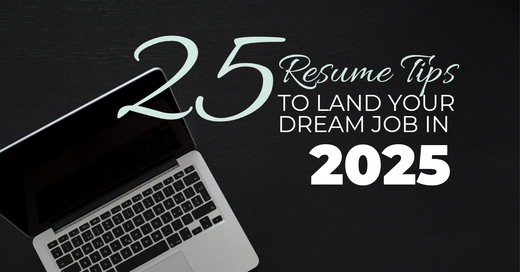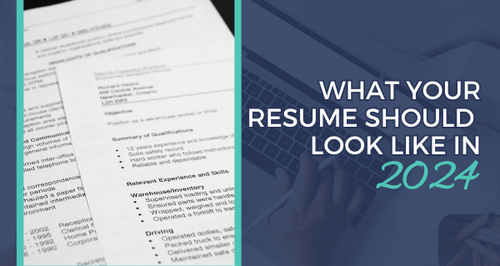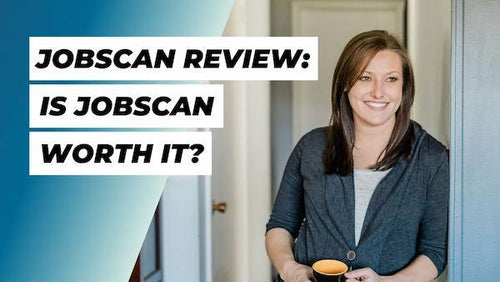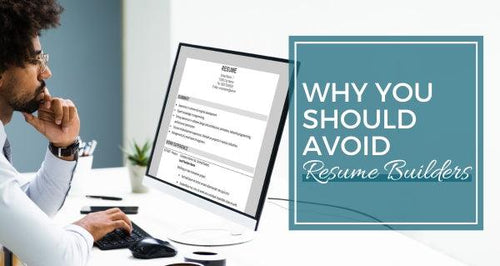
25 Resume Tips To Land Your Dream Job In 2025
This list of resume tips for 2025 has carefully curated the best practices and insights that have helped my clients land interviews in a matter of days and job offers in less than 60 days (even as few as two weeks!) after updating, revamping, or newly crafting their resumes.
Let me start by asking you, what’s keeping you from updating your resume?
I hear this scenario far too often from job seekers.
You dread going to work every morning. You do it because you need to pay the bills and chip away at that looming debt you’re reminded of with every monthly statement.
You get an email or text from an old friend, former co-worker, or industry connection that you made years ago about a job opening with a company you’ve been discreetly stalking online for weeks. All you need to do is send over your resume or apply online tonight, and the job is practically yours.
It only takes one look at your resume, and you feel defeated. You haven’t touched it in years. It doesn’t even have your most recent job listed, and its overall look and feel hasn’t changed much over time. You’re pretty sure it looks as ineffective as you feel after a long day at work.
Then there’s all this talk online about ATS, AI, bots, and algorithms that will “kick you out” if you don’t know how to beat the system. Let me reassure you right now, this doesn’t actually happen.
Resume writing is often the most dreaded task for job seekers because either:
- You have a difficult time talking about yourself in a resume,
- You have a hard time quantifying skill sets, and your edu-crastination (You like that?) has only instilled in you that quantifying your skills is the only way to get an interview,
- You have no idea what to do with your overly diversified experience or work history timeline issues like multiple company acquisitions, demotions, or changing job titles;
- The “dark cloud” of hiring technologies is hanging over you, or
- You’re just too exhausted to work on your resume after work.
Here are 25 actionable steps you can take to write a resume that lands more interviews, job offers, and, ultimately, your dream job this year.

This blog contains affiliate links, meaning I may receive a small commission (at no cost to you) if you subscribe or buy something through the links I share. I only share links to products or services that I use myself or absolutely love!
1 | Understand Your Resume’s Role In The Hiring Process
The #1 complaint from job seekers in the last five years has been, “My resume isn’t getting in front of the right people!” I get how frustrating, time-consuming, and often discouraging looking and applying for jobs online can be. Understanding your resume’s role in the hiring process is the first step to creating a job-winning resume that gets you unstuck and moving forward confidently.
Granted this can vary depending on company size and industry, here’s the SparkNotes version of the typical hiring process:
- A team leader or manager realizes they need to create or fill a position and notifies the HR team.
- Someone on that HR team creates a job description based on the team leader/manager’s needs and posts it to the company’s Applicant Tracking System (also known as ATS) which is linked to the company’s Careers page.
- The HR staff member then posts the job to job boards as well as LinkedIn, ZipRecruiter, Glassdoor, and other sites depending on their budget.
- The Applicant Tracking software collects resumes and applications from hundreds of job seekers, narrowing down applicants to the most qualified candidates using search terms and “knock-out” questions from the applications.
- The top qualified candidates (maybe the top 10) will have their resumes looked at by the recruiter or HR team who will have their own checklist of requirements and preferences.
- Out of the resumes seen, the top candidates (maybe the top 6) will get phone screening interviews.
- Out of the candidates screened, the top candidates (maybe the top 4) will have their resumes forwarded to that team leader or hiring manager to be considered for an in-person interview.
- Out of the interviewed candidates, the top candidate (maybe more depending on the hiring circumstances) will get the job offer.
2 | Write For All Readers, Not Just Bots
Now that you understand your resume’s role in the hiring process, you can see that your resume needs to get through an Applicant Tracking System and two other gateways before you are selected for a job interview. A common misconception about resume writing is that your top priority has to be writing your resume for computers or the bots that operate within ATS.
Resume writing is actually a balancing act. You have to write your resume for three different audiences: ATS, a recruiter or HR, and a hiring manager or direct supervisor deciding who will get the interview.
ATS is looking at both the digital formatting of your resume and the keywords you’ve included throughout. The HR reader likely has a checklist of requirements and preferences that they use as terms to search, sort, or filter through applicants, so you can’t assume this person will know that you have certain skills and experience based on your job titles. A hiring manager or direct supervisor will then need to decide who is the best fit for the job, the team, and the company as a whole among the handful of applicants that made it this far in the process.
3 | Stop Fearing Artificial Intelligence
If anything, AI is going to make it easier for you to land interviews.
Most of the AI-driven features being used by hiring professionals are to write better job postings and improve communications with candidates. AI can also be used to help recruiters and hiring professionals find candidates on networks like LinkedIn based on search terms like position titles and skills—where AI branches out from these search terms to find candidates with similar position titles and skills. LinkedIn is also providing AI-driven features for recruiters that will recommend profile matches before jobs are even posted.
Other hiring software, like Applicant Tracking Systems, have similar AI integrations. What’s most exciting is that some ATS have AI capabilities that will help gauge an applicant’s level of experience beyond calculating years of work history listed keyword placement. Instead of just looking at keywords, it’s looking at everything you’re saying in your resume and drawing conclusions about your skills and experience.
If you’re providing enough context throughout your resume to show the results or outcomes an employer can expect from you based on past performance, AI will help drive your resume to the top of applicant lists.
4 | Narrow Down Your Job Target
The most effective, job-winning resume is going to be targeted for a specific job. If you’re applying for jobs online, this means the specific job posting. If you’re networking, this means you need to get laser-focused on what your ideal role is to position yourself as the best fit for the job that you want.
Targeting your resume shows that you understand the goals of the role you’re applying for or pursuing in your job search. A targeted resume will also demonstrate that you can meet and exceed those goals based on your track record over the course of your work history and educational background.
If you can’t narrow down your job target, you should either create a targeted resume for each of your job targets or consider working with a career coach. Career Exploration & Transition Coaching is highly recommended if you need help getting a clear direction and focus for your job search!
5 | Design Your Resume For ATS
The next step is designing your resume for Applicant Tracking Systems. This software has been around since the 90s—so there’s a ton of outdated information online about it—but ATS has evolved dramatically over the last 5-10 years. Here’s what you need to know:
- Applicant Tracking Systems can’t read text placed in headers or footers, so be careful where you place your contact information in MS Word Documents.
- Applicant Tracking Systems can’t read text placed in text boxes, so avoid using these to organize information on your resume.
- Applicant Tracking Systems scan the text from left to right and often don’t read and store information formatted in columns correctly.
- Applicant Tracking Systems don’t care about bold, underlined, italicized, colored, or color-filled text so you can use these design elements strategically to make your resume easier to skim.
- Applicant Tracking Systems don’t see photos, graphs, or charts embedded in your resume (JPG or PNG files)—just don’t rely on them to convey important information that isn’t in the text.
- Applicant Tracking Systems can read PDFs but are known to read MS Word Documents more accurately—heavily formatted and graphically designed PDF resumes specifically often can’t be previewed in ATS.
To maximize your chances of getting through ATS, start with a new Microsoft Word Document and organize your information in a one-column layout. Make sure your contact information can be found in the body of your resume rather than in the header or footer.
Keep in mind that Applicant Tracking software is designed to look for certain keywords and text arrangements to fill in a form with your information within the software. Use standard section headings (Skills or Areas of Expertise, Experience, Education, Certifications, etc.) to make sure your information is parsed and organized in this software’s searchable database correctly.
Related Article: ATS Explained: How Resume Screening Software Works
6 | Use Color Strategically (& Conservatively)
If your resume looks like every other black-and-white resume from the 90s, you’re not helping yourself at all. Your resume isn’t just a list of your work history and skills—it’s a marketing document, and color psychology is a key branding tactic used in marketing. Your personal brand, or how you want to present yourself to employers using both visual cues and messaging, is directly linked to your personality. Would you want to hire a black-and-white personality?
Use color strategically to impact an employer’s perspective of you. Keep your resume looking professional by using conservative color for your name, section headings, and other design elements sparingly. Pick no more than two colors, but keep the rest of your text easy to read with a standard black font.
Is the thought of getting creative with your resume design giving you anxiety? I’ve already done the heavy lifting for you and designed modern resume templates for college students and recent graduates, those making major career changes, mid-career professionals, and IT professionals in a variety of color schemes.
Struggling to get through Applicant Tracking Software? These templates are designed to get through ATS and stand out in all the right ways when in front of hiring decision-makers
7 | Include Your LinkedIn Profile Link
If you’re not on LinkedIn, you're already falling behind other applicants. Why? Your LinkedIn profile is often the first stop during a background check because it’s an easy and free way for HR teams to validate your work history. I won’t even get into how LinkedIn recommendations on your profile are the new letters of recommendation…
Related Article: How To Get Raving LinkedIn Recommendations
A LinkedIn profile also enables you to humanize your job application when it’s less professional on a resume such as non-career-related volunteer experience, side projects, and work-life balance activities. It’s your profile on a networking platform, so it should be more approachable and conversational. An even more important advantage is this: You can add more information to your LinkedIn profile than a targeted 1-2 page resume will permit.
Add your LinkedIn profile link to your contact information on your resume and indicate at the end of your resume that more information can be found on your profile to speed up the background check and boost your application.
8 | Remove Dates Older Than 2010
Can you believe that 2010 was 14 years ago?! Unless you’re applying for a job that specifically wants 15+ years of experience with a particular skill (which is becoming less common for many executive-level roles), listing dates on your resume prior to 2010 is only going to age you… and not in a good way.
Age bias and discrimination are serious issues that impact job seekers over 45 more often than they realize, but there are other negative responses to drawing attention to your age on your resume. For example, your extended years of experience may be threatening to a potential younger manager. The extended years of experience may also imply that you’re only looking to bridge an employment gap until a better-fitting job opportunity presents itself.
The extended years can give the impression that you’re fixated on outdated methodologies, best practices, and technologies rather than present you as a forward-thinking professional.
I often work with seasoned job seekers in their 50s and 60s looking for their last job before retirement, drastically changing careers, or returning to work after an early retirement. Eliminating half of their careers from their resumes can be terrifying at first but so rewarding in a matter of weeks. Removing work history prior to 2010 can bring focus to your resume and show employers that you’re more interested in the future than your past.
9 | Learn How To Analyze Job Postings
Job postings were created by HR teams based on the staffing needs described by a team leader or hiring manager. They tell you exactly what they’re looking for in an ideal candidate, so why would you leave these details off your resume? I’ve worked with a handful of job seekers who insisted on removing critically important details from their resumes because they didn’t want employers to expect them to do certain tasks… It’s mind-boggling to me.
Analyzing job postings isn’t as technical or challenging as it may sound. You can use an online keyword analysis tool like Jobscan.
Related Article: Is Jobscan Worth It? Jobscan Review (2024 Update)
Or you can read through the job posting from the perspective of an employer and answer these questions:
- What are the top goals for this role?
- What are the required qualifications and preferred skills for this job?
- What traits will an ideal candidate have?
- What other words or phrases describe the role or work?
If you can read through a job posting and identify the answers to these questions, then you’ll know what needs to be on your resume to present you as the best fit for the job.
10 | Identify The Top 8 Job-related Skills
Some job postings are formidable. They are challenging enough to skim through—let alone analyze—and will give you the impression that even the most senior executive of that company isn’t the right fit for the job. Your resume doesn’t need to list every single qualification and desired trait listed on the job posting. If it did, your resume would look like it was 100% copied and pasted from the job posting.
You can avoid that by identifying the top 8 job-related qualifications and skills to focus on within your resume. It’s more important that your resume contains the highest-weighted keywords that Applicant Tracking Systems will be looking for while still sounding like you’re telling your story for the human reader.
Remember, it’s the balancing act that gives you credibility.
11 | Know The Company’s Mission & Vision
If you don’t know the company’s mission and vision, you have no business applying for the job. Your role at any given company is to help that company meet its goals. If you can show that you understand this in your resume, you’re going to stand out from the candidates still starting their resumes with a self-serving Objective Statement or boring Resume Summary.
This information is usually in the company description paragraph in a job posting, but can also be found on:
- The company website
- Glassdoor
- Other social media profiles
Indicating that you understand the mission and vision of your previous employer by describing how your efforts contributed to these in your resume will also give you a competitive advantage.
12 | Introduce Yourself With A Branding Statement
Speaking of outdated Objective Statements and boring Resume Summaries, your resume is not about you. Yes, you read that right. Get rid of that self-serving introduction that is frankly wasting valuable real estate. Once your resume gets in front of a human reader, the top third of your resume is the first (and often the only) section that will be read, so make it count!
Encourage the reader to get to know you more by creating a Branding Statement that doesn’t just introduce your qualifications or highlight your top job-related skills but really showcases the unique value you offer or the results you will produce for the employer in a short paragraph (no more than 4-6 lines).
Need to nix that outdated Objective Statement or boring Summary? This Branding Statement Cheat Sheet will help you position yourself as the best fit for the job you want
13 | Make Your Experience Section Easy To Skim
Nearly every resume I’ve seen, prior to working with the job seeker, suffers from one of these three crippling afflictions:
- Long blocks of text with no bullets which forces the reader to read every line of the resume in order to find the details they’re looking for (qualifications, skills, achievements, etc.)
- Too many bullets which also forces the reader to read every line of the resume to find the details they’re looking for (qualifications, skills, achievements, etc.)
- Not enough information to determine if you’re the best fit for the job or not
If your resume suffers from either of the first two afflictions, I have bad news for you. Corporate recruiters, HR professionals, and hiring managers are not going to spend the time reading each and every line of your resume before deciding whether or not you’re going to move forward in the hiring process. If your resume takes more than 6 seconds to skim, it will likely be tossed.
Make your Experience section easy to skim by alternating between short paragraph summaries and bullet lists that draw attention to your achievements, major contributions, or top skills in action.
14 | Add Keywords To Your Job Summaries
Your resume needs to tell employers that you are the best fit for the job. If your resume doesn’t have enough information to achieve this, here’s a quick and easy fix for you. Briefly describe the typical tasks and responsibilities you held, but only those that relate to the job you’re applying for. This is particularly successful for job seekers targeting higher-level positions or changing careers entirely.
Better yet, optimize your job summaries by adding keywords found in the job posting. These are often the search terms used to search, sort, and filter through applicants and will greatly improve your ranking when your resume is battling Applicant Tracking Systems. Plus, it shows employers that you’re paying attention to their terminology.
15 | Follow This Storytelling Framework
Don’t just say you have excellent project management skills or that you’ve managed projects. In writing classes, you’ll frequently hear the phrase, “Show, don’t tell.” This concept is especially true for writing a great resume. Don’t just claim you have certain skills and abilities, but tell your unique story of how you made a difference by applying those skills and abilities in the workplace.
Your resume should highlight how you demonstrated certain skills and what resulted in a fair amount of context. The storytelling framework that corporate recruiters and hiring managers love to see looks something like this:
Results or what you achieved + compared to before or why your efforts were necessary + the actions you took or skill(s) you applied
If this sounds like a time-consuming way to update your resume, it doesn’t have to be.
Give employers what they want! This Skills Auditor and bonus Work History Examples Guide helps you organize your skills and translate them into action-oriented statements for your Experience section
16 | Don’t Hide Your Resilience During The Pandemic
So many people were impacted by the spread of COVID-19 in 2020. Whether you lost your job, started working from home for the first time in your career, or juggled work and at-home schooling for your children, you had to pivot and make changes to your daily routines. Amplify your resume with these transferable skills!
Fill this space in your Experience section with the volunteer experience, continued education, professional development, or at-home experiences that demonstrate:
- Leadership Development
- Skills Development
- Flexibility/Adaptability
- Change Management
- Process Improvement
If you were fortunate enough to not be furloughed or laid off, make sure to update your Experience section with examples of how you’ve led or influenced change that enabled you to continue driving business or serving your customers.
17 | Own Your Gaps
When your resume is a little top-empty, meaning you’ve been unemployed or taking an extended leave of absence, there are several tactics that can help you take ownership of your gaps without distracting employers from your qualifications.
For example, I worked with a client who intentionally planned for and took a career sabbatical to travel for 2 years. During that time, he inconsistently did some part-time consulting in his field but he couldn’t share details publicly on his resume. He also started a podcast where he shared industry-related insights and expertise. We used this information to own his gap by summarizing the cultural experience while traveling, the consulting experience, and the thought leadership experience.
Here are a few other practical ways to fill the gap:
- Working on a certification program or taking college courses? You can fill the gap by listing “(Area of Study) Student” as your job title, “(Institute or University Name)” as your employer, and summarizing the coursework or projects you’ve completed for your experience.
- Caring for family members? You can fill the gap by listing “Stay-at-home Parent” or “Caregiver” as your job title, “(Last Name) Home” as your employer, and summarizing your most relevant transferable skills in action as your experience.
- Traveled or re-entering the workplace after a few years of retirement? Briefly but transparently summarize how you spent your time, even if it isn’t related to your new career goals. If you gained or utilized any relevant transferable skills, great! If not, keep this light and short (1-2 lines max).
18 | Showcase Your Achievements & Major Contributions
If you think a flashy graphic resume design is what you need to stand out, you’re not thinking like an employer. Measurable achievements—or achievements that you can quantify—matter more than anything else on your resume! The measurable achievements you have made are unique to you and play a key role in presenting the unique value you offer to employers.
Don’t get caught up in thinking, “I’m not in sales, so I can’t come up with any measurable achievements.” Describing the results of any major contribution that you made toward achieving company or department goals constitutes an achievement even if quantifying it might be a bit more difficult.
Related Article: How To Add More Achievements To Your Resume
19 | Stand Out The Right Way With Context
It isn’t enough to state that you have certain skills or abilities on your resume. When working with new clients, I used to ask, “What do you think makes you stand out from other applicants?” The answers were commonly some version of “my skills” or “my years of experience.” The reality is that most applicants will have similar skills and years of experience!
So what makes you stand out from these applicants? It’s the context you can provide that shows your level of experience or the scope of your work.
For example, how large was the budget that you managed? Someone with experience managing a multimillion-dollar budget is clearly at a different level than someone managing a budget under $500K. Or how widespread was the team that you oversaw? Someone who oversees a geographically dispersed team of managers with their own teams has a larger scope of responsibility than someone who has only supervised a team of 3. Or by how much did you complete a project prior to the deadline - in 3 months or in 3 days?
20 | Weave In Your Soft Skills Appropriately
While your resume should focus on the top functional job-related skills and experience you have, soft skills can help hiring decision-makers determine how good of a fit you'll be for the team. Soft skills, or transferable skills, are often mistakable added to Skills section when they're more effective when weaved in throughout your Experience section.
Your resume, cover letter, and LinkedIn profile are examples of your communication skills. You can also add a line to a job summary paragraph that describes how you've communicated or presented complex topics to diverse audiences.
When your create an achievement bullet with context, you can demonstrate your problem solving skills in a practical way that resume readers understand without blatantly writing the words, "problem solving skills. You can add a line to a job summary paragraph that describes how you've collaborated with cross-functional teams during a project.
Instead of saying you're a "lifelong learner," create a separate section at the end of your resume titled "Continuous Education" or "Recent Training" listing the free and paid courses you've taken. Ultimately, your want to make sure that the soft skills you want to highlight in your resume relate to the goals of the role or else they may be looked at as "fluff."
21 | Streamline Your Work History Timeline
Applicant Tracking Systems and HR teams want to see a clear, consistent work history timeline. HR teams are often more forgiving, but getting past ATS is still your first challenge. This may mean adjusting the timeline you’re listing on your resume, and I’m not talking about changing dates or lying.
You can downplay gaps in employment by listing only your last so many years of uninterrupted work history and summarizing your previous experience without dates in a short Additional Experience note at the end of your Experience section. Streamlining your work history timeline may also mean removing shorter-term and less relevant positions to eliminate the appearance of “job-hopping.”
Your resume should be a snapshot of your most relevant skills and experience, not an autobiography.
22 | Keep Interest On Your Qualifications, Not Your Age
I know I touched on this before by indicating that dates older than 2010 have no place on your resume (unless indicated for an executive-level role), but there are other details on your resume that may be drawing more attention to your age than your qualifications.
- Unless you are a high school student, remove your high school & graduation date.
- Unless you graduated within the last five years, remove college graduation dates.
- If you have an aol.com or yahoo.com email address, consider creating a free Gmail or Outlook account.
- Remove outdated software skills (or software versions for you, IT job seekers!)
If you’re questioning why age is such a turn-off to employers, think about it from their perspective. Drawing attention to 20+ years of experience can also imply that you desire a higher salary than another qualified candidate listing fewer years of experience. Even if you’re experience doesn’t imply a desired salary outside of their budget, a clearly younger candidate may be a safer bet when it comes to training and culture fit.
23 | Trim Down Your Education Section
Why certain industries (like technology) require college degrees still baffles me! Much of the information learned in college will be obsolete in 5-10 years, but it’s still a prominent qualification that gives many job seekers anxiety. There are still a vast number of employers who value experience over higher education, and your Education section may actually be hindering you from landing the jobs you want.
If you’re applying for a job requiring a bachelor’s degree but you’re listing your advanced degrees (e.g. master’s or doctorate), you may be presenting yourself as overqualified or too expensive. Your advanced degree is a HUGE accomplishment, but you need to target your Education section to reflect the desires of the company.
Missing a required or preferred college degree? Using LinkedIn for personal branding, networking, and employer targeting can help you get your foot in the door and bypass ATS altogether!
24 | Proofread & Edit For Human Readers
Job seekers often fall into a trap when they spend hours researching how to write a resume that gets through ATS. They get a little keyword-crazy and even start copying and pasting general statements from job postings directly into their resume.
Fortunately for you, Applicant Tracking Systems are getting smarter. Most modern ATS has evolved to search for messages rather than keywords. You now have the freedom to tell your unique story without having to use the words and phrases verbatim from the job posting.
Once you’ve finished writing your resume, read through and proofread it for human readability. Does it sound like a robot wrote it, or does it sound like your unique career story?
25 | Update Your Resume Regularly
How often do you update your resume? Let me guess… once a year or every few years when you hear about a great job opportunity. That’s usually when my clients come back to me looking to update their resumes!
Don’t put unnecessary stress on yourself. Start keeping a list of any projects (large or small) or contributions made toward achieving company goals every month. Every six months, update your resume to reflect changing responsibilities or achievements. When you complete on-the-job training or online courses to keep your skills fresh, add them to your resume.
The key is to always be prepared to apply for a new and better job when it presents itself instead of scrambling to make a great first impression.
Conclusion
Resume writing is a balancing act, and your resume has to be written for three audiences: Applicant Tracking Systems with or without AI, recruiters or HR teams with and without in-depth knowledge of your field or industry, and a hiring manager or direct supervisor deciding who stands out as the best fit. Writing a great resume means telling your unique career story while naturally integrating the keywords ATS will be looking for to narrow down applicants to the most qualified candidates.
If your resume isn’t landing you many interviews, use this list of resume tips for 2025 to refresh your resume and start positioning yourself as the best fit for the job that you want.
Related Articles
-

The Best Resume Tips for Recent Law School Graduates
Guest contributor Luke Bell shares practical resume tips to help recent law school graduates make a lasting impression on potential employers.
-

What Employers Look For In A Resume Skills Section
Learn which key components of an effective Skills section can indicate to resume screening software and the recruiters behind it which skills are your most recent, relevant, functional job-related skills.
-

What Your Resume Should Look Like In 2024
This comprehensive resume guide shares what the most common resume sections are and what your resume should look like in 2024.
-

Is Jobscan Worth It? Jobscan Review (2024 Update)
Have you heard of Jobscan? Learn more about this keyword analysis tool for job seekers, what it costs, and what Certified Resume Writers both love and hate about it in this in-depth product review.
-

How To Showcase Transferable Skills And Your Value For A Career Transition
Recognizing the significance of transferable skills is key to successfully showcasing one's potential in the face of change.
-

How To Showcase Achievements In Your Cover Letter
Learn how to turn your accomplishments into a compelling personal narrative that showcases the results an employer can expect from you.
-

Why You Should Avoid Resume Builders
Online resume builders are an enticing resume resource, but as a Certified Resume Writer who has tried them out, I recommend avoiding them.
-

ChatGPT Review: Resume Writing Edition
How useful is ChatGPT in crafting a resume that lands interviews and job offers? This review by a Certified Resume Writer isn’t what you’d expect.
-

Are Resume Templates Bad?
Certified Resume Writer Steph Cartwright shares the pros and cons of resume templates and which ones you should avoid at all costs.













